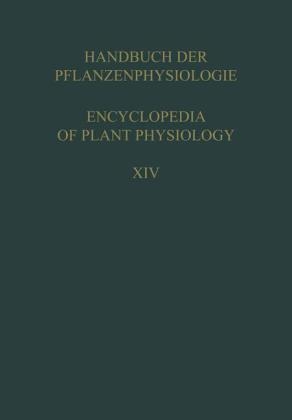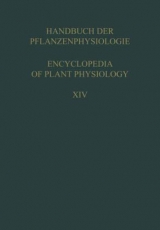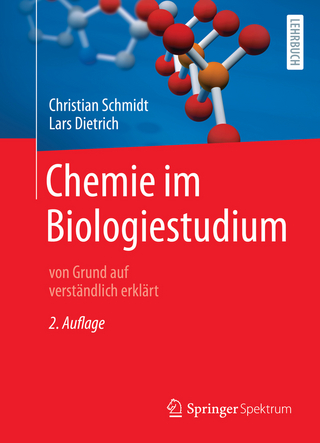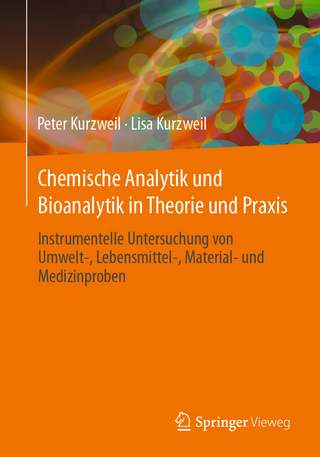Growth and Growth Substances / Wachstum und Wuchsstoffe
Springer Berlin (Verlag)
978-3-642-48936-5 (ISBN)
- Titel wird leider nicht erscheinen
- Artikel merken
Inhaltsverzeichnis—Contents.- II. General survey.- I. Definition of growth.- II. Growth and development.- Cellular character and growth.- Meristems.- Differential growth.- Growth patterns.- Rates of growth.- Growth and size.- Growth and correlation.- Cellular behavior and growth.- Genes and growth.- III. Growth types in different plant groups.- Literature.- III. Anatomische Grundlagen des Wachstums.- I. Das Wachstum der Zelle.- 1. Das Plasmawachstum.- 2. Das Wachstum der Zellwand.- a) Neubildung von Membranen bei der Teilung.- b) Das Streckungswachstum der Zellwand.- c) Das Differenzierungswachstum der Zellwand.- II. Das Wachstum der Gewebe und Organe.- 1. Zonen des aktiven Plasmawachstums.- 2. Zonen des Membranwachstums.- a) Die Wurzel.- b) Die Sproßachse.- c) Seitenorgane.- 3. Orte der Gewebedifferenzierung.- III. Anhang.- Literatur.- IV. Wachstum als Gesamtprozeß.- A. Methoden der Wachstumsmessung.- I. Einleitung.- II. Längenmessung.- 1. Direktmessung mit Hilfe eines Maßstabes.- 2. Zeiger am Bogen nach Sachs u. a.- 3. Auxanograph.- 4. Magnetische Auxanometer.- 5. Spiegelauxanometer.- 6. Torsionsauxanometer von V. Ubisch.- 7. Aufhängung des Objektes.- 8. Interferometer nach Meissner und Laibach.- 9. Auxanometer von Koningsberger.- 10. Horizontalmikroskop.- Markierungen.- Das Horizontalmikroskop.- 11. Kinematographische Registriermethode.- III. Messung von Krümmungen und Circumnutationsbewegungen.- IV. Dicken- und Umfangsmessung.- V. Flächenmessung.- 1. Direkte Flächenmessung.- 2. Photoelektrische Methode.- 3. Flächenmessung auf Grund der Konstanz der Blattformen.- VI. Volumenmessung.- Mikropotetometer nach Cholodny.- Literatur.- B. Growth as a general process.- I. Introduction.- II. The grand period of growth.- III. The progress of growth-formulas, rates, and interpretations.- 1. Lower plants.- a) Individual cells.- b) Populations.- 2. Higher plants.- a) Over-all growth.- b) The shoot apex.- c) The root.- d) Differential growth.- e) The leaf.- f) The flower.- g) The fruit.- 3. Cell division and cell growth.- IV. Temperature and growth.- Conclusion.- Literature.- C. Energetik des Wachstums.- a) Gesamtenergiebilanz des Wachstums.- I. Grundbegriffe.- 1. Definition und Maß der Energie.- 2. Der erste Hauptsatz.- 3. Die maximale Arbeitsfähigkeit reversibler Reaktionen.- 4. Der reale Nutzeffekt (Wirkungsgrad).- 5. Die energetische Koppelung.- II. Die Energiebilanz des Wachstums.- 1. Der energetische Wirkungsgrad der Photo- und Chemosynthese.- 2. Der energetische Wirkungsgrad der Energiebereitstellung in der Zelle.- 3. Der Energiebedarf des stationären Zustandes (die „Erhaltungsenergie“).- 4. Die Gesamtarbeit während des Wachstums.- a) Der Energiebedarf einiger Synthesen.- Polysaccharide.- Fette.- Eiweiß.- b) Der Energiebedarf der Oberflächenvergrößerung.- c) Der Energiebedarf der Membrandehnung.- d) Der Energiebedarf anderer Teilprozesse des Wachstums.- 5. Die Gesamtenergiebilanz des Wachstums.- a) Der ökonomische Koeffizient (Pfeffer-Koeffizient).- b) Der „Aufbau-Quotient“und der „Synthetische Wirkungsgrad“.- c) Der „Rubner-Koeffizient“.- d) Der „Terroine-Koeffizient“.- e) Der wahre energetische Wirkungsgrad des Wachstums („machine efficiency“).- III. Die Beziehung zwischen der Gesamtenergiebilanz des Wachstums und der Wachstumsintensität.- Literatur.- b) Wachstum und Atmung.- I. Einleitung.- II. Der Zusammenhang zwischen Atmungs- und Wachstumsintensität.- 1. Zur Methodik der Messungen.- 2. Die Beziehungen in den verschiedenen Organismen bzw. Organen.- a) Einzeller.- Heterotrophe Organismen.- Autotrophe Organismen.- b) Thallophyten.- c) Befruchtete Eizelle.- d) Keimende Samen und Sporen.- e) Sprosse und Knospen.- f) Blätter.- g) Wurzeln.- h) Blütenorgane und Früchte.- i) Unorganisiertes Gewebe.- III. Die Art der Beziehungen zwischen Wachstum und Atmung.- 1. Die Atmung als Energiequelle.- 2. Die Atmung als Bau- und Wirkstofflieferant des Wachstums.- Literatur.- V. Die einzelnen Wachstumsprozesse.- A. Plasmawachstum.- a) Stoffsynthese und Plasmawachstum.- I. Einleitung.- II. Die Voraussetzungen des Plasmawachstums.- III. Die Vermehrung der einzelnen Plasmabestandteile.- 1. Nucleinsäuren.- 2. Proteine.- Die Bausteine der Proteine und ihre Bildung.- 3. Lipoidsubstanzen.- IV. Die Koordination der Einzelsynthesen.- Literatur.- b) Le rôle du noyau cellulaire dans les synthèses.- I. Introduction.- II. Matériaux favorables à l’étude du rôle du noyau cellulaire dans les synthèses.- 1. Recherches sur des cellules intactes.- 2. Emploi de fragments d’organismes unicellulaires ou d’œufs.- 3. Emploi d’homogénats cellulaires.- III. Examen des principaux résultats expérimentaux.- 1. Expériences faites sur des cellules intactes.- 2. Expériences faites sur des fragments d’organismes unicellulaires.- 3. Expériences faites sur des homogénats.- IV. Conclusions et résumé.- Bibliographie.- c) Mechanismus der identischen Reproduktion.- Literatur.- B. Physiologie der Kern- und Zellteilung.- a) The growth of the nucleus.- 1. Changes in volume during nuclear growth.- 2. Changes in amount of DNA during nuclear growth.- 3. Changes in amount of RNA during nuclear growth.- 4. Changes in amount of basic proteins during nuclear growth.- 5. Changes in other proteins of the nucleus during growth.- 6. Conclusion: a generalized hypothesis for nuclear growth prior to division in meristems of roots.- Literature.- b) The physiology of mitosis.- I. The initiation of mitosis.- 1. Temperature.- 2. Radiations.- 3. Nutritional factors and chemical components of the cell.- 4. Energy relations.- II. The cell in mitosis.- 1. Prophase and metaphase.- 2. The spindle.- 3. Temperature.- 4. Velocities of chromosome movements.- 5. Chemicals.- 6. Humoral and systemic control: nucleus and cytoplasm.- Literature.- c) Physiologie der Meiosis.- I. Die Auslösung der Meiosis.- II. Die Physiologie der Chromosomenpaarung und -Verteilung.- 1. Meiosen mit veränderter Zahl der Teilungsschritte.- 2. Die Paarung.- 3. Centromer und Spindelmechanismus.- 4. Spiralisation und Röntgenempfindlichkeit der Chromosomen in der Meiose.- Literatur.- d) Vermehrung anderer Zellorganellen.- 1. Beweise für die Vermehrung der Piastiden mittels Durchschnürung.- 2. Verteilung der Piastiden bei der Zellteilung.- 3. Piastidenteilung unter Berücksichtigung der genetischen Piastidenautonomie und Piastidenstruktur.- 4. Chondriosomen und Mikrosomen.- Literatur.- C. Zellstreckung und Wandwachstum.- a) Zellstreckung und Stoffwechsel.- I. Einleitung.- II. Die Schicksale der einzelnen Zellteile während der Streckung und die kausale Verknüpfung der Veränderungen mit dem Streckungsvorgang.- 1. Die Zellmembran.- 2. Das Plasma.- 3. Der Zellkern.- 4. Die Vacuole.- III. Der Energiebedarf der Zellstreckung und seine Deckung.- Literatur.- b) Physics of cell elongation.- A. The osmotic and water conditions.- a) Anatonosis. Osmoregulation.- b) Cell wall tensility.- c) The rôle of turgor.- d) Additional factors in water absorption. The term A.- B. Cytoplasmic factors in cell elongation.- C. Temperature.- D. Light.- a) Occurrence of a light sensitive elongation. Etiolation.- b) Light-growth reactions.- c) Spectral sensitivity.- d) Light perception.- e) Mechanism of the light actions.- Literature.- c) The growth of the cell wall.- I. General survey of the problem.- II. Increase in wall area.- 1. Increase in wall area during cell division.- 2. Increase in area during cell vacuolation.- a) The chemical composition of primary walls.- b) Electron-microscopical appearance of growing cell walls.- c) The physical properties of growing walls and hypotheses of growth.- Structural properties.- Mechanical properties and the effect of growth substances.- III. The walls of growing cells as part of the living cell.- Literature.- VI. Die chemische Regulierung des Wachstums.- A. General survey.- The scope of growth-substance research.- Terminology of growth substances.- Literature.- B. Growth factors: Metabolic factors limiting growth.- a) General introduction.- b) Bacteria and fungi.- I. Historical sketch.- II. The growth response.- III. Synthesis and function.- IV. Growth factor requirements as systematic characters.- V. The growth factors.- 1. Thiamine.- 2. Riboflavin.- 3. Nicotinic acid.- 4. Pantothenic acid.- 5. Pyridoxine.- 6. Biotin.- 7. The folic acid group.- 8. p-Aminobenzoic acid.- 9. The vitamin B12 group.- 10. Lipoic acid.- 11. Inositol.- 12. Amino acids, amides, amines, and peptides.- 13. Nucleic acid constituents.- 14. Fatty acids.- 15. Miscellaneous growth factors.- Literature.- c) Phytoflagellates and algae.- I. Introduction.- II. Thiamine.- III. Cobalamin.- IV. Biotin.- V. Other growth factors.- VI. Ecology.- VII. Conclusion.- Literature.- d) Vitamins as growth factors in higher plants.- I. Introduction.- II. The occurrence, biosynthesis, biochemical function and growth effects of different vitamins.- 1. Vitamin A and carotenoids.- 2. Thiamine and lipoic acid.- 3. Riboflavin.- 4. Nicotinic acid.- 5. Pantothenic acid.- 6. Pyridoxine.- 7. Biotin.- 8. Folic acid and p-aminobenzoic acid.- 9. Vitamin B12.- 10. Inositol.- 11. Choline.- 12. Vitamin C.- 13. Vitamin D.- 14. Vitamin E.- 15. Vitamin K.- 16. Vitamin P.- 17. Amino acids.- 18. Purines and pyrimidines.- III. The effects of vitamins in different types of growth processes.- 1. Tissue culture.- 2. Excised root culture.- 3. Stems, buds and leaves.- 4. Excised flowers and ovaries. Pollen tubes.- 5. Decotylised and immature embryos.- 6. Cuttings and decapitated plants.- 7. Parasites and mycotrophic plants.- 8. Intact normal plants.- Literature.- C. Die Auxine.- a) Historische Übersicht.- I. Die Entdeckung der Existenz der Auxine.- II. Die Aufhellung der Bedeutung der Auxine.- 1. Tropismen.- 2. Streckungswachstum.- 3. Callusbildung und Cambiumtätigkeit.- 4. Parthenokarpie.- 5. Wurzelbildung.- 6. Korrelative Hemmung.- 7. Schlußbetrachtung.- III. Die Aufklärung der chemischen Konstitution der Wuchsstoffe. Nomenklatur.- 1. Natürlich vorkommende Wuchsstoffe.- 2. Synthetische Wuchsstoffe. Herbizide. Antagonismus und Synergismus von Wuchsstoffen.- 3. Nomenklatur der Wuchsstoffe.- Literatur.- b) Die biogenen Auxine.- 1. Chemistry of the native auxins.- I. Auxins a and b.- II. Naturally-occurring indole compounds.- III. Biogenesis of the indole auxins.- IV. Unidentified auxins.- Literature.- 2. Reinigungs- und Bestimmungsmethoden.- ?) Extraction and purification of auxins.- I. Extraction.- 1. Diffusion into agar.- 2. Solvent extraction.- 3. Choice of extraction solvents.- 4. Enzymatic and hydrolytic methods for extracting “bound” auxins.- II. Purification of extracts.- 1. Partition between solvents.- 2. Paper chromatography.- 3. Column chromatography.- 4. Charcoal adsorption and displacement analysis.- Literature.- ?) Chemical determination of auxins.- 1. The Salkowski reaction.- 2. The Ehrlich reaction.- 3. Other location reagents.- 4. Quantitative determinations.- a) Fluorescence.- b) Spot area on chromatograms.- c) Absorption spectra.- d) Optical density of coloured reactants.- Literature.- ?) Biological determination of natural auxins.- I. Introduction.- a) Principles.- b) General equipment.- II. The Avena coleoptile curvature test.- a) Morphology and anatomy of the Avena seedling.- b) Test procedure.- Historical development.- Technique.- c) Transfer of auxin to suitable carriers.- Agar tests.- Lanolin tests.- d) The response and its measurement.- e) Variability of various modifications of the test.- f) Sensitivity of the test.- g) Expression of test results. Auxin units.- III. Other curvature tests using symmetric test objects.- IV. Tests based on straight growth of coleoptiles or stems.- a) Coleoptile section tests.- b) The Avena internode section test.- c) The pea-stem section test.- d) Straight growth of decapitated seedlings.- V. The pollen tube test.- VI. Root-growth tests.- a) Intact seedlings on filter paper.- b) Intact seedlings on agar.- c) Intact seedlings growing in solutions.- d) Root sections on filter paper.- e) Root sections growing in solutions.- f) Excised roots growing in solutions.- g) Decapitated roots.- VII. Responses of asymmetrical test objects.- a) The slit pea-stem curvature test.- b) The Ageratum petiole curvature test.- VIII. Tests involving morphogenetic and correlative phenomena.- a) Petiole abscission tests.- b) Root formation tests.- IX. Assay of growth retarding activity.- No synthetic auxin added to the test objects.- Auxin supplied externally to the test objects.- Physiological separation of growth promoting and growth retarding activity.- Literature.- 3. Vorkommen und Verteilung der Auxine in der Pflanze.- I. Die Vergleichbarkeit der Wuchsstoffbestimmungen in den verschiedenen Organen und Entwicklungszuständen der Pflanze.- II. Die Wuchsstoffverteilung in der Pflanze im Verlauf ihrer Entwicklung.- 1. Keimpflanzen.- 2. Beblätterte Triebe.- 3. Blütenknospen und Blüten.- 4. Früchte.- 5. Samen.- 6. Wurzeln.- III. Der Wuchsstoffhaushalt verwandter Rassen und Arten.- IV. Anhang. Der Wuchsstoffhaushalt viruskranker Pflanzen.- Literatur.- 4. The states of auxin in the plant.- 1. Naturally-occurring auxin complexes.- 2. Ascorbigen.- 3. Interconvertible auxins.- 4. Auxin-protein complexes.- 5. Binding of applied auxins.- 6. Indolyl acetyl peptides.- 7. Physiological significance of auxin complexes.- Literature.- 5. The biogenesis of auxin.- I. Introduction.- II. Sites of biogenesis.- III. Tryptophan as a primary precursor.- IV. Tryptophan as a precursor in normal auxin biogenesis.- V. Enzymatic pathways of tryptophan conversion.- 1. Ring cleavage.- 2. Side-chain degradation.- a) Oxidative deamination.- b) Transamination.- c) Deamination by polyphenols.- d) Amino acid decarboxylation.- e) Amine deamination.- f) Oxidation of the aldehyde.- g) Degradation of the keto-acid and some ancillary reactions.- 3. Recapitulation and some general considerations.- Literature.- 6. The degradation of auxin.- I. Introduction.- Definition of terms.- Criteria of degradation or inactivation.- II. Stability and non-enzymatic degradation of the IAA molecule.- 1. Acid and base stability — “spontaneous” decomposition.- 2. Degradation by ionizing radiations.- 3. Degradation by ultraviolet light (UV).- 4. Degradation by visible light.- 5. Degradation by peroxides, and oxidation through various redox systems.- a) Peroxides.- b) Manganic ion.- c) Nitrite.- d) Bisulfite.- e) Oxygen.- f) Illuminating gas.- 6. The non-enzymatic degradation of IAA.- Summary.- III. Enzymatic degradation of IAA.- 1. Early work.- 2. Occurrence of IAA oxidase systems.- 3. Components of the IAA oxidase system.- a) Enzymes.- b) Cofactors.- c) Inhibitors.- 4. Products of the reaction.- 5. Specificity of the enzymatic reaction.- 6. Mechanism of the reaction.- 7. The physiological significance of enzymatic IAA oxidation.- a) General considerations.- b) Activity in homogenates, tissue slices, and intact tissue.- c) IAA oxidase activity and physiological age of the cell.- d) IAA oxidase activity and growth habit.- e) Auxin destruction and flowering habit.- f) Auxin destruction and growth under water.- g) Auxin destruction and leaf fall.- h) Effect of 2,4-D on in vivo auxin destruction.- 8. Enzymatic degradation of IAA.- Summary.- Literature.- 7. The transport of auxin.- I. Polarity of transport.- II. Quantitative properties of auxin transport.- III. On the mechanism of transport.- IV. Physiological implications of transport.- Literature.- 8. The effect of external factors on auxin content.- I. Introductory.- 1. Definitions and methodology.- 2. Purpose and significance of studies on the effects of external factors on auxin content.- II. Temperature.- III. Mineral nutrition.- 1. Nitrogen.- 2. Zinc, copper and manganese.- 3. Boron.- 4. Phosphorus.- 5. Hydrogen ion concentration.- IV. Ionizing radiations and ultraviolet.- 1. X-rays.- 2. Ultraviolet (UV).- V. Visible light.- 1. High intensity light on intact green plants.- 2. Effects of photoperiod.- 3. Effects on etiolated materials and roots.- VI. Chemicals.- 1. Ethylene.- 2. Maleic hydrazide (MH).- 3. 2,4-Dichlorophenoxyacetic acid (2,4-D).- 4. Gibberellic acid.- 5. Miscellaneous.- VII. Abnormal growth and pathology.- 1. Root-nodule bacteria.- 2. Crown gall.- 3. Virus diseases in the potato.- 4. Effects of other pathogens.- VIII. Mutilation of the plant.- Literature.- c) Die Physiologie der Auxinwirkung.- 1. Die Wirkungsweise des Auxins in der Zelle.- ?) Die Wirkung der Wuchsstoffe auf die Zellwand.- I. Einleitung.- II. Bau der Zellwand und ihre strukturellen Veränderungen während des Streckungswachstums.- III. Wuchsstoffe und Wanddehnbarkeit.- IV. Ausnutzung des Turgordruckes zur Bestimmung der Dehnungseigenschaften der Zellwand.- V. Analyse des Mechanismus der wuchsstoffinduzierten Dehnbarkeitsänderung der Zellmembran.- Literatur.- ?) Die Wirkung der Wuchsstoffe auf das Plasma.- A. Einleitung.- B. Wuchsstoffe und Protoplasmaströmung.- C. Wuchsstoffe und Permeabilität.- D. Wuchsstoffe und Polarität.- E. Wuchsstoffe und Potentiale.- Literatur.- y) Wuchsstoffe und Wasseraufnahme.- I. Allgemeine Problematik.- II. Analyse der Wuchsstoffwirkung auf die Wasseraufnahme.- 1. Wuchsstoffe und Saugkraft der Zelle.- 2. Wuchsstoffe und osmotischer Wert des Zellinhaltes.- 3. Wuchsstoffe und Ausbildung einer nichtosmotischen Kraft.- 4. Wuchsstoffe und Herabsetzung des Wanddruckes.- Literatur.- ?) The relation between auxin and metabolism.- I. The dependence of auxin-induced growth upon metabolism.- 1. Evidence for a dependence of auxin-action upon metabolism.- 2. Evidence for the independence of auxin-action from metabolism.- II. Auxin and respiration.- 1. Investigations with Avena coleoptiles.- 2. The influence of auxin upon the respiration of other tissues.- 3. The relation between auxin-induced expansion and auxin-induced increases in respiration rate.- a) Respiration rate as influenced by varying concentrations of auxin.- b) Evidence for an indirect action of auxin upon respiration.- c) Evidence for a direct action of auxin upon respiration.- d) Herbicidal concentrations of auxin and respiration.- e) Auxin and the respiration of lower plants.- f) The relation between auxin and respiration.- III. Auxin and the specific components of metabolism.- 1. Introduction.- 2. Carbohydrate metabolism other than cell wall metabolism.- a) Introduction.- b) Respiratory quotient.- c) Glycolysis.- d) Auxin and gross changes in cellular carbohydrates.- e) Inhibitor studies.- f) Enzyme studies, in vivo and in vitro.- g) Conclusions.- 3. Nitrogen metabolism and auxin.- 4. Auxin and the metabolism of high energy phosphates.- 5. Cell wall metabolism and auxin.- a) The metabolism of cell wall carbohydrates.- b) Cell wall methylation.- c) Conclusions.- Literature.- 2. Die Bedeutung des Auxins für die Zellstreckung.- ?) L’action des auxines sur la croissance des cellules.- I. Généralités.- II. Importance de la concentration.- III. Croissance des membranes.- IV. Facteurs endogènes.- V. Pénétration de l’eau.- VI. Extensibilité des parois.- VII. Structure des parois.- VIII. Les phases d’allongement.- IX. Facteurs limitants.- X. Conclusion.- Bibliographie.- ?) Theories of the auxin action on cellular elongation. A summary.- Auxin-induced increases in the outward pressure of the cell contents.- Auxin-induced reduction of wall pressure.- Other proposed mechanisms of auxin-action.- Mechanisms of growth inhibition.- Conclusions.- 3. Die Bedeutung des Auxins für die Zellteilung.- a) Meristeme, Oewebekulturen.- I. Wuchsstoff und Cambiumtätigkeit.- II. Wuchsstoff und Organanschwellungen.- III. Wuchsstoff und Gewebekultur.- Literatur.- ß) Auxin in the regulation of abscission.- I. Introduction.- II. Auxin analyses.- III. Retardation of abscission.- IV. Acceleration of abscission.- V. Discussion.- VI. Summary.- Literature.- 4. Morphogene und korrelative Wirkungen.- ?) Différenciation. Formation des racines et des bourgeons.- I. La différenciation.- 1. Caractères généraux de la différenciation.- 2. Les facteurs de la spécificité des différenciations.- 3. Physiologie de la différenciation. Rôle de l’auxine.- II. La néoformation des racines et des bourgeons.- 1. Introduction.- 2. Rôle de F auxine dans la rhizogenèse.- d) Les inhibiteurs de la rhizogenèse.- 3. Rôle de l’auxine dans la formation des bourgeons.- a) Caulogenèse et concentrations auxiniques.- b) La notion de caulocaline.- c) La conception de Skoog.- d) Caulogenèse et inhibition de bourgeons.- Bibliographie.- ?) Dominance apicale. Tropismes, épinastie.- I. Dominance apicale.- 1. Rôle de l’auxine dans les correlations d’inhibition.- Mais cette conception a soulevé de très nombreuses objections.- Deux types de réponses ont alors été proposées pour expliquer le rôle de l’auxine.- 2. Les inhibitions par carence.- a) Carence d’un précurseur de l’auxine.- b) Carence en substances hormonales spécifiques.- c) Carences trophiques provoquées par l’auxine.- 3. Inhibition par présence d’une hormone de corrélations.- 4. Inhibitions résultant d’une interaction entre la présence d’un inhibiteur hormonal et certaines carences.- a) Les rameaux anticipés des végétaux ligneux.- b) L’influence des cotylédons dans les corrélations entre les rameaux cotylédonaires.- c) Les interactions entre auxine et kinétine.- d) La ramification du lin.- e) La ramification sur le rameau d’un an des végétaux ligneux.- Deux idées se dégagent de ces faits.- Or, expérimentalement, il a été possible de prouver que.- Pour conclure brièvement.- II. Auxine et tropismes.- 1. Origine des idées actuelles sur les relations entre auxine et tropismes.- 2. Tropismes et action directe du stimulus sur les cellules (effets Blaauw).- a) Le gradient transversal d’éclairement.- Comportement des coléoptiles.- Comportement des sporangiophores et des rhizoïdes.- b) Réaction indépendante des deux faces d’un même organe.- c) Perturbation par la lumière des réactions cellulaires à l’auxine.- d) Influence directe de la lumière sur l’auxine.- Action sur la synthèse de l’hormone de croissance.- Les réactions de photoinactivation de l’auxine.- 3. Tropismes et répartition inégale de l’auxine par migration. (Théorie Cholodny-Wekt.).- a) Le déplacement latéral de l’auxine dans les différents organes 893 Coléoptiles et tiges.- Géotropisme.- Phototropisme.- Feuilles et pétioles.- Racines.- b) Relations quantitatives entre la répartition inégale de l’auxine et les courbures observées.- c) Mécanisme conduisant à une répartition inégale de l’auxine.- 4. Particularité du géotropisme de racines.- a) Comportement de la racine de blé.- b) Comportement de la racine de pois.- 5. Auxines, épinastie et plagiotropisme.- Bibliographie.- ?) Auxins in flowering.- I. Introduction.- II. Effects of auxins on ripeness-to-flower and earliness.- 1. Effects on ripeness-to-flower.- 2. “Seed hormonization“.- 3. “Chemical vernalization“.- III. Effects of auxins in flower initiation.- 1. Indeterminate plants.- 2. Cold-requiring plants.- 3. Short-day plants.- 4. Long-day plants.- 5. Long-short-day plants.- 6. Special cases.- 7. Review.- IV. Auxin effects in flower and inflorescence development.- 1. Growth of flowers and flower parts.- 2. Sex expression.- 3. Auxin and the growth of the flower stalk.- V. Effects of maleic hydrazide in flowering.- Literature.- ?) Development of fruits.- I. Pollination.- II. Development of the ovary into the mature fruit.- 1. Ovules and seeds as a source of hormone.- 2. Influence of seeds on fruit growth.- 3. Parthenocarpy.- 4. Part played by cell division and cell enlargement in fruit growth.- 5. Nutritional level.- 6. Auxin effect on translocation of materials within a plant.- III. Conclusion.- Literature.- d) Spezielle Probleme der synthetischen Auxine und Auxinhomologen.- 1. Chemical structure and growth activity of auxins and antiauxins.- I. Introduction. Statement of problems.- Definitions.- Abbreviations.- II. Summary of factual knowledge. Types of active compounds.- 1. Carboxylic acids.- 2. Acid compounds other than carboxylic acids.- 3. Neutral compounds.- 4. Amines.- III. Structure-activity rules.- IV. Tabular survey of the behaviour of certain compounds in tests for auxin activity.- Literature.- 2. Kinetics of auxin-induced growth.- I. Development of the kinetics.- 1. Techniques.- 2. Growth-auxin relationships.- 3. Competitive auxin action at a common growth site.- 4. Antiauxin action at a common growth site.- 5. Growth inhibition at supraoptimal auxin concentrations.- 6. Antiauxin action at supraoptimal auxin concentrations.- 7. A test of the two-point attachment hypothesis of auxin action.- 8. Some growth problems of auxin kinetics.- 9. Growth kinetics of Kaindl and Linser.- II. An examination of the kinetics.- 1. Auxin transport and permeability factors.- 2. Factors influencing coleoptile section growth.- 3. Discussion.- a) Foster-Bonner auxin kinetics.- b) Kaindl-Linser kinetics.- Literature.- 3. Absorption and migration of synthetic auxins and homologous compounds.- Uptake by roots.- Uptake by leaves.- Role of cuticle.- Routes of entry.- Distribution in the plant.- Effect of ionization.- Uptake of maleic hydrazide.- Lipoidal vs. aqueous route.- Literature.- 4. Metabolism and mode of action.- I. Introduction. Statement of the problems.- II. Metabolism.- 1. Persistence of stimulus.- 2. The use of labelled compounds for tracing metabolic changes in synthetic auxins.- 3. Metabolism by micro-organisms.- III. The mechanism of action of the synthetic auxins.- 1. The identical nature of the actions of IAA and synthetic auxins in the regulation of coleoptile growth.- 2. Synthetic auxin-IAA differences.- Literature.- 5. Morphogenese effects of synthetic auxins.- I. Introduction.- II. Rooting of cuttings.- III. Fruit development, fruit set, and parthenocarpy.- 1. Influence of auxins on germination and growth of pollen tubes in vitro.- 2. Influence of auxins on the growth of the pollen tube in the style.- 3. Abscission of the style.- 4. Fruit growth.- 5. Fruit set.- 6. Parthenocarpy.- IV. Flowering.- 1. Induction or prevention of flowering by auxins.- 2. Inhibition of flowering.- 3. Promotion of flowering.- V. Abscission.- Literature.- 6. Effects on the composition and metabolism of the entire plant.- 1. Introduction.- 2. Moisture.- 3. Minerals.- 4. Nitrogen metabolism.- 5. Carbohydrates.- 6. Photosynthesis.- 7. Respiration.- 8. Enzymes.- 9. Vitamins.- 10. Indoleacetic acid.- 11. Oil.- 12. Pigments.- 13. Coumarin.- Literature.- 7. Applications of auxins in agriculture and their physiological bases.- I. The trigger action of auxins.- II. Flower induction in the pineapple.- III. Fruit setting.- IV. Benefits of raising low auxin levels in fruit artificially.- V. Auxin induced fruit drop.- VI. Root formation.- VII. Weed control.- VIII. Physiology and biochemistry of 2,4-D.- Literature.- Oibberellins and plant growth*.- D. Other biogenous growth promoters.- Literature.- E. Biogenous inhibitors.- I. Introduction.- II. Demonstration of growth-inhibiting substances.- 1. Separation of growth-inhibiting substances from auxins.- 2. Test methods.- Avena coleoptile curvature test.- Intact coleoptiles.- Decapitated coleoptiles.- Pea curvature test.- Straight growth test.- Pea test.- Root test.- Pollen tube test.- Germination test.- III. The occurrence of growth-inhibiting substances in different plant organs.- Leaves.- Coleoptiles.- Stems and shoots.- Tubers.- Buds.- Boots.- Stamens and pollens.- Fruits and seeds.- IV. The chemical nature of the inhibitors.- V. The interaction of auxin and inhibitor in the plant.- VI. The role of the growth-inhibiting substances in the different stages of growth.- Inhibition of root growth.- Root formation.- Shoot formation.- Rest.- Bud correlation.- Literature.- F. Gibberellins and plant growth.- I. Introduction.- II. Historical background.- III. Assays.- 1. Physico-chemical assays.- 2. Biological assays.- IV. Chemistry of the gibberellins.- 1. Chemical properties.- 2. Isolation of gibberellins from Fusarium moniliforme.- 3. Structural studies on the fungal gibberellins.- 4. Isolation and structure of gibberellins from angiosperms.- 5. The relation of structure to biological activity.- 6. Biosynthesis of gibberellins.- V. Gibberellin-like substances from flowering plants.- VI. Anatomical effects.- VII. Gibberellin-induced growth.- General growth responses.- VIII. Physiological considerations.- Shoot growth.- Literature.- Namenverzeichnis — Author Index.- Sachverzeichnis (Deutsch-Englisch).- Subject Index (English-German).
| Reihe/Serie | Handbuch der Pflanzenphysiologie Encyclopedia of Plant Physiology |
|---|---|
| Mitarbeit |
Mitglied der Redaktion: H. Burström |
| Verlagsort | Berlin |
| Sprache | englisch; französisch; deutsch |
| Maße | 170 x 244 mm |
| Einbandart | Paperback |
| Themenwelt | Naturwissenschaften ► Biologie ► Biochemie |
| Naturwissenschaften ► Biologie ► Botanik | |
| Schlagworte | Atmung • Cell • Development • growth • Pflanzenwachstum • Pflanzenwuchsstoff • Plant • Plant growth • plants • respiration • tissue • Wachstum |
| ISBN-10 | 3-642-48936-2 / 3642489362 |
| ISBN-13 | 978-3-642-48936-5 / 9783642489365 |
| Zustand | Neuware |
| Haben Sie eine Frage zum Produkt? |
aus dem Bereich




